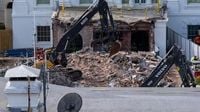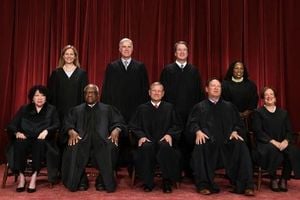The East Wing of the White House, long considered the heartbeat of the presidential residence and a symbol of the evolving role of America’s first ladies, now exists only in memory and photographs. Last week, demolition crews completed the tear-down of the two-story wing, erasing more than a century of history tied to the nation’s most powerful women and their causes. In its place, President Donald Trump has set his sights on a $300 million gold-gilded ballroom, funded by a mix of private corporations and headline-making settlements, according to reporting from multiple outlets including The Washington Post and the Associated Press.
For generations, the East Wing was more than just an architectural appendage to the White House. It was, as Betty Ford once put it, the “heart” of the nation’s executive home, balancing the “mind” of the West Wing. From organizing elaborate state dinners to spearheading national campaigns, first ladies and their teams made history within its walls. The wing housed not only offices and reception rooms but also a movie theater, a covered walkway, and a garden dedicated to Jacqueline Kennedy—each a silent witness to the evolving role of the first lady.
The demolition, completed on October 23, 2025, was swift. Excavators arrived just days before, and by Thursday, the East Wing was reduced to rubble. The move, ordered by President Trump as part of his second-term agenda, was not without controversy. Trump, who has reportedly been fixated on building a grand White House ballroom since at least 2010, finally seized the opportunity to realize what he calls a “great legacy project.” He had previously offered to build such a ballroom for President Barack Obama—a gesture that went unheeded at the time, according to the Associated Press.
Supporters of the project, like Anita McBride, former chief of staff to first lady Laura Bush, argue that the ballroom is a practical improvement. McBride told the Associated Press, “The large and expensive tent option that has been used when guest lists stretched longer than could be comfortably accommodated inside the White House was not sustainable.” She pointed out that tents damage the lawn and require extra infrastructure, especially during bad weather. “Tearing down those walls doesn’t diminish the significance of the work we accomplished there,” she added, reflecting a pragmatic view of the change.
But not everyone agrees. Krish O’Mara Vignarajah, former policy director for first lady Michelle Obama, called the demolition a “symbolic blow” to the East Wing’s legacy as a place where women shaped history. “The East Wing was this physical space that had seen the role of the first lady evolve from a social hostess into a powerful advocate on a range of issues,” she said in an interview with the Associated Press.
The editorial board of The Washington Post, owned by Amazon founder Jeff Bezos, weighed in with a forceful endorsement of the demolition and the ballroom plan. “The White House cannot simply be a museum to the past. Like America, it must evolve with the times to maintain its greatness. Strong leaders reject calcification. In that way, Trump’s undertaking is a shot across the bow at NIMBYs everywhere,” the board wrote in an October 25 editorial. The Post’s opinion section, recently overhauled by Bezos to focus on “personal liberties and free markets,” praised Trump for joining a long list of presidents who have left their mark on the White House—from Theodore Roosevelt’s West Wing to Harry S. Truman’s famous balcony.
The editorial acknowledged that fundraising for the ballroom, which involves major corporations such as Amazon, Comcast, Apple, Meta, Microsoft, T-Mobile, and Google, creates “problematic conflicts of interest.” Google’s parent company, Alphabet, agreed to pay Trump $22 million as part of settling a lawsuit over YouTube’s suspension of his account, with the funds earmarked for the ballroom project. Despite these ethical concerns, the Post’s editorial board concluded that “Trump’s aggressive approach is justified,” arguing that traditional review processes would have stalled the project indefinitely.
For all its symbolism, the East Wing was also a place of personal stories and national milestones. Rosalynn Carter was the first first lady to claim her own office in the East Wing, seeking a private workspace separate from the family quarters. “I always need a place to go that is private, where I don’t have to dress and don’t have to put on makeup,” she wrote in her memoir. Nancy Reagan launched her iconic “Just Say No” anti-drug campaign from the same wing, a movement that began during a visit with schoolchildren in California. “A little girl raised her hand and said, ‘Mrs. Reagan, what do you do if somebody offers you drugs?’ And I said, ‘Well, you just say no.’ And there it was born,” Reagan recalled.
Hillary Clinton broke with tradition by moving her office to the West Wing, seeking closer integration with the president’s team—a move that drew both attention and criticism. Laura Bush’s staff, mostly in their twenties, fled the East Wing in the aftermath of the September 11 attacks, only to return to work in a building now considered a target. Michelle Obama, the first Black woman to serve as first lady, used the East Wing as a base for her “Let’s Move” campaign, support for military families, and advocacy for girls’ education worldwide. Melania Trump, who delayed her move to Washington to keep her son in school, eventually launched her “Be Best” initiative from the East Wing. Jill Biden, the first first lady to maintain a career outside the White House, continued teaching while championing military families and cancer research.
The demolition also erased the White House’s 42-seat movie theater, installed by FDR in 1942. Over the years, the theater hosted everything from Richard Nixon’s viewing of “Patton” to Barack Obama’s screenings with Hollywood casts and crews. Even President Trump reportedly watched Billy Wilder’s “Sunset Boulevard” there, adding his own layer to the theater’s storied past.
As the dust settles, debate rages on. Preservationists and advocates for women’s history lament the loss, while supporters hail the new ballroom as a necessary evolution. The project’s corporate funding and the speed of its approval have raised eyebrows, but its defenders argue that the White House, like the country it represents, must keep moving forward. The East Wing may be gone, but the conversations it sparked—and the legacies it housed—are far from forgotten.





